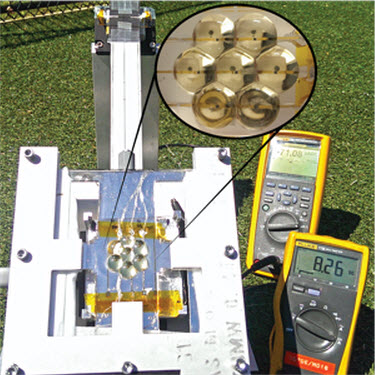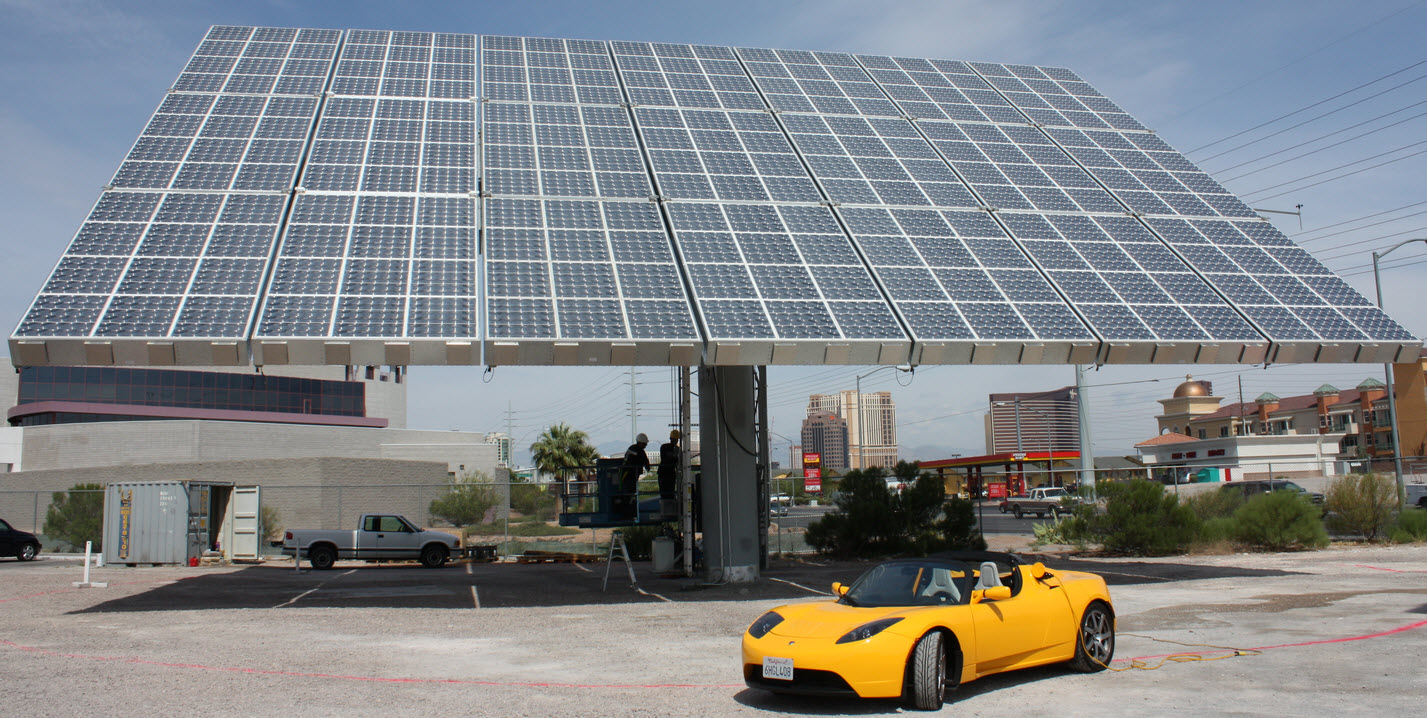High-efficiency concentrating solar cells move to the rooftop
February 6, 2015

Prototype rooftop CPV solar panel being tested outdoors. The small black squares under each lenslet in the close-up are the solar cells. (Credit: Nature Communications)
Ultra-high-efficiency multi-junction solar cells similar to those used in space or electric utilities may now be possible on your rooftop thanks to a new microscale solar-concentration technology called concentrating photovoltaic (CPV) developed by an international team of researchers.
The new CPV systems use inexpensive optics to concentrate sunlight,” said Noel C. Giebink, assistant professor of electrical engineering, Penn State. “Current CPV systems are the size of billboards and have to be pointed very accurately to track the sun throughout the day. You can’t put a system like this on your roof.”

This Amonix CPV installation for an electric utility uses thousands of small lenses, each focusing sunlight at about 500 times higher intensity onto a tiny, high-efficiency multi-junction photovoltaic cell — Tesla Roadster not included (credit: Mbudzi/Creative Commons)
Fortunately, the falling cost of typical silicon solar cells — from about 20 percent for silicon to more than 40 percent with the new CPV — is making them a smaller and smaller fraction of the overall cost of solar electricity (which includes permitting, wiring, installation and maintenance).
Adapting CPV for rooftops
To enable CPV on rooftops, the researchers combined miniaturized gallium-arsenide photovoltaic cells, 3D-printed plastic lens arrays, and a moveable focusing mechanism. That combination reduces the size, weight and cost of the CPV system, allowing it to be installed on the south-facing side of a building’s roof.
They reported their results Thursday (Feb. 5) in Nature Communications.
“We partnered with colleagues at the University of Illinois because they are experts at making small, very efficient multi-junction solar cells,” said Giebink. “These cells are less than 1 square millimeter, made in large, parallel batches, and then an array of them is transferred onto a thin sheet of glass or plastic.”
Penn State University | Concentrating Photovoltaic systems leverage the cost of high efficiency multi-junction solar cells by using inexpensive optics to concentrate sunlight (credit: C Roy Parker/Penn State University)
To focus sunlight on the array of cells, the researchers embedded them between a pair of 3D-printed plastic lenslet arrays. Each lenslet in the top array acts like a small magnifying glass and is matched to a lenslet in the bottom array that functions like a concave mirror. With each tiny solar cell located in the focus of this duo, sunlight is intensified more than 200 times. To track the Sun over the course of a day, the middle solar cell sheet slides laterally in between the two lenslet arrays.
Schematic illustration of a microtracking microcell CPV panel array of microcell photovoltaics, transfer-printed on a central acrylic sheet that tracks the Sun by sliding laterally between stationary upper and lower acrylic lenslet arrays (credit: Nature Communications)
Previous attempts at such translation-based tracking have only worked for about two hours a day because the focal point moves out of the plane of the solar cells, leading to loss of light and a drop in efficiency. By sandwiching the cells between the lenslet arrays, the researchers solved this problem and enabled efficient solar focusing for a full eight hour day with only about 1 centimeter of total movement needed for tracking.
To lubricate the sliding cell array and also improve transmission through the lenslet sandwich, they used an optical oil, which allows for small motors using a minimal amount of force for mechanical tracking.
“The vision is that such a microtracking CPV panel could be placed on a roof in the same space as a traditional solar panel and generate a lot more power,” said Giebink. “The simplicity of this solution is really what gives it practical value.”
Because the total panel thickness is only about a centimeter and 99 percent of it — everything except the solar cells and their wiring — consists of acrylic plastic or Plexiglas, this system has the potential to be inexpensive to produce.
Direct sunlight required
Giebink cautions, however, that CPV only makes sense in areas with lots of direct sunlight, like the American Southwest. “In cloudy regions like the Pacific Northwest, CPV systems can’t concentrate the diffuse light and they lose their efficiency advantage.”
The researchers tested their prototype concentrator panel outside over the course of a day in State College, Penn. Even though the printed plastic lenses were not up to specification, they were able to demonstrate more than 100 times solar concentration.
Researchers at University of Illinois, Urbana Champaign and LUXeXcel Group B.V., The Netherlands were also involved. The U.S. Department of Energy funded this research.
Abstract for Wide-angle planar microtracking for quasi-static microcell concentrating photovoltaics
Concentrating photovoltaics (CPV) offer a route to lower the cost of solar power, however the existing paradigm based on precise orientation of large-area concentrator modules toward the Sun limits CPV deployment to large, open land areas. Here, we explore an alternate approach using high efficiency microcell photovoltaics embedded between a pair of plastic lenslet arrays to demonstrate quasi-static CPV panels < 1 cm thick that accomplish full-day tracking through small (<1 cm) lateral translation at fixed latitude tilt. Using both commercial off-the-shelf optics and 3D printed lenslet arrays, we validate this approach through direct outdoor testing and show that it enables flux concentration >200x with >70% optical efficiency over a 120° field of view that is sufficient for year-round operation. Per unit of installed land area, cosine projection loss for fixed microtracking CPV panels is ultimately offset by improved ground coverage relative to their conventional dual-axis counterparts, enabling a ~1.9x increase in daily energy output that may open up a new opportunity for compact, high-efficiency CPV in rooftop installations and other limited-space urban environments.